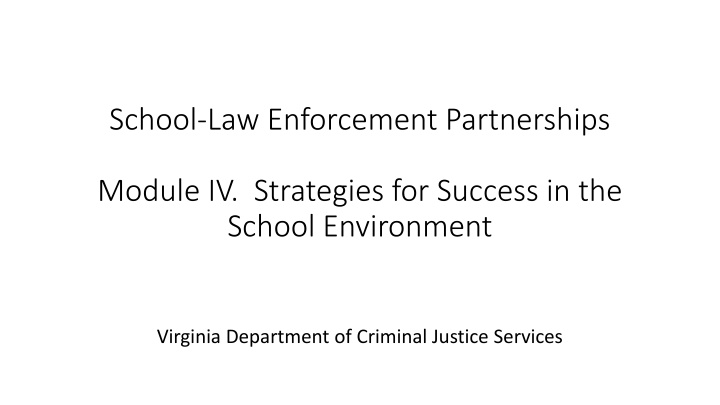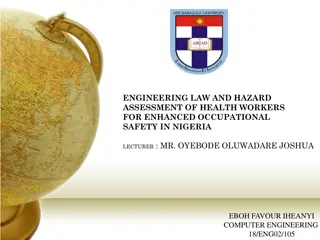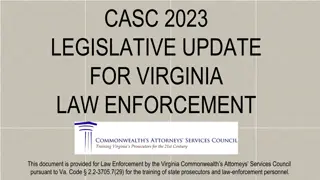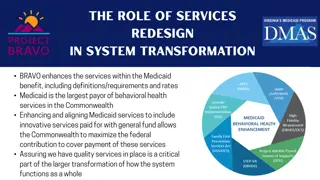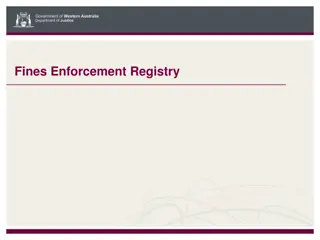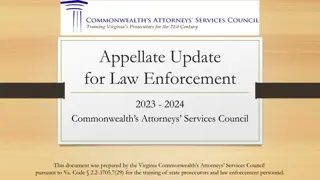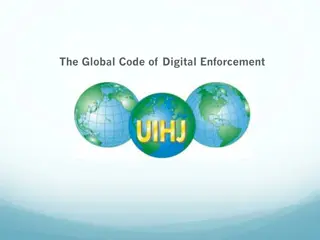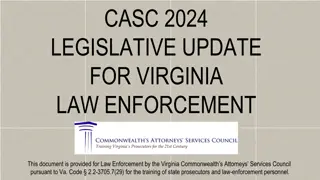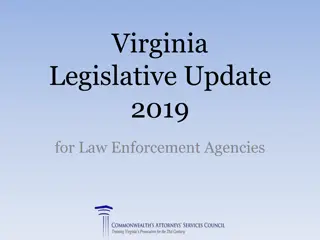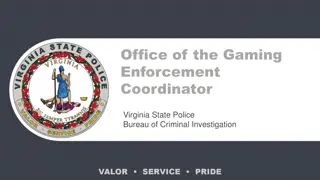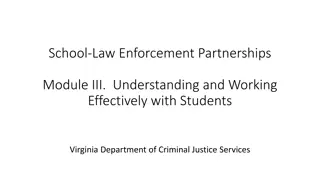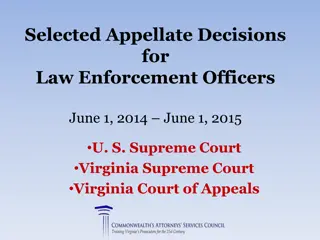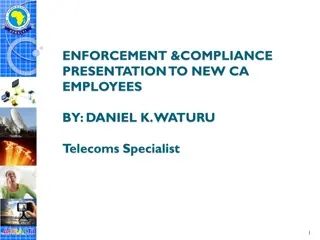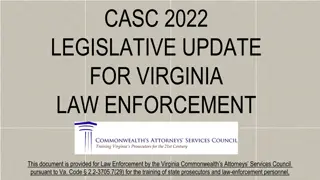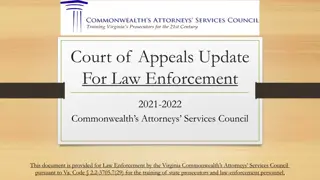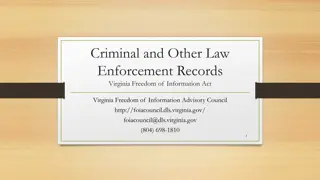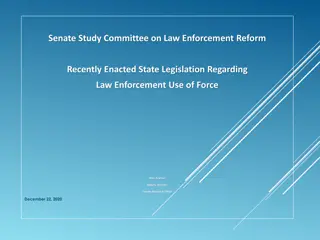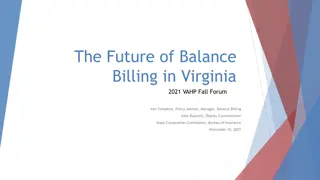Strategies for Successful School-Law Enforcement Partnerships in Virginia
Module IV discusses building-based school personnel roles and their connection with School Resource Officers (SROs), discipline data reporting, common school programs for safety, and key tools/resources for SRO professional development. It highlights the critical collaborative relationship between principals and SROs, the roles of various school community members, and the importance of specialists and operations staff in school safety.
Download Presentation

Please find below an Image/Link to download the presentation.
The content on the website is provided AS IS for your information and personal use only. It may not be sold, licensed, or shared on other websites without obtaining consent from the author.If you encounter any issues during the download, it is possible that the publisher has removed the file from their server.
You are allowed to download the files provided on this website for personal or commercial use, subject to the condition that they are used lawfully. All files are the property of their respective owners.
The content on the website is provided AS IS for your information and personal use only. It may not be sold, licensed, or shared on other websites without obtaining consent from the author.
E N D
Presentation Transcript
School-Law Enforcement Partnerships Module IV. Strategies for Success in the School Environment Virginia Department of Criminal Justice Services
Overview of Module IV Building-based school personnel and how their roles connect with SRO; How discipline data reporting works and how to use the data; Common school programs and supports that address problems associated with school and student safety; and Key tools and resources for ongoing SRO professional development.
Members of the School Community Members of school community Principals, Assistant Principals Instructional Staff teachers, instr. aids Specialists counselor, psychologist, social worker, therapists School Security Officer Operations Staff custodian, cafeteria workers, bus drivers Coaches Also in school community students, parents, business/civic Agencies that serve families social services, mental health, etc.
Principals: The Critical Collaborative Relationship Principals Instructional Leaders Oversee day-to-day operation With SRO, determines how partnership operates at the specific school. Collaborative nature of relationship with SRO Exercise of authority and discretion to interest of student and welfare of the school community.
Specialists See role descriptions in the SLEP Guide School counselors usually serve 1 school; knowledgeable about students & school resources & operations. School nurses usually assigned to 1 school; especially critical in emergencies & critical incidents. School social workers usually itinerate; knowledgeable about families & community resources. School psychologists usually itinerate; can inform decisions about students related to threat assessment and disciplinary action. Therapists (speech, physical, occupational) usually itinerate; often work with students with disabilities.
Operations Staff Often overlooked, but important Custodians and maintenance and cafeteria personnel Especially knowledgeable about the school s physical plant and operation. Important to be involved with school crisis planning and preparation. May be well positioned to observe concerning behaviors. Bus drivers familiar with neighborhoods and with activities at and around bus stops. Involved with management of conduct on bus and reporting of incidents occurring on buses and at bus stops. Important to be involved with school crisis planning and preparation, especially evacuations to other locations.
School Security Officers Both SSOs and SROs have school security responsibilities; coordination important. More detailed information on SSOs in SLEP Guide. As a rule, Law enforcement officers take the lead when there are serious criminal violations; School officials take the lead on school violations; and Roles of SSOs are specified by the employing school division.
Comparison of SRO and SSO Roles School Security Officer A school employee Complying with and guided by local school policies and regulations School Resource Officer A law enforcement agency employee Complying with federal and state laws and local ordinances Functions under the direction of local school principal or designee Primarily assigned to school campus activities Responsible for enforcing school policy Responsible for detaining individuals Functions under the direction of law enforcement command Assigned to school and community activities Responsible for enforcing laws Responsible for custody and arrest in conformance with law
Comparison of SRO SSO Roles School Security Officer School Resource Officer Can search students based upon reasonable suspicion in accordance with local school board policy Search in accordance with State and Federal laws; search requires probable cause or permission May detain and question students Laws and custody requirement procedures apply Act under the standards of law Act in absence of parents (in loco parentis) Use of force should be limited and only used in accordance with local school policy Use of force is permissible as guided by department policy
Broader School Community School of 1,500 students but number in broader community much higher Table of Key Members of SLEP - demonstrates the broad range of community members Remember those technically outside the school including: Parents Local businesses and civic groups Community-based agencies serving children and families including Community Services Boards (CSBs), Court Service Units (CSUs), Departments of Social Services (DSSs).
School Personnel Training on SRO Roles & Procedures School Personnel Training important accurate expectations about SRO roles school-specific operational procedures Recommendations plan for initial and ongoing/refresher training strongly recommended SRO attend training on student issues offered by school (e.g., mental health conditions, substance abuse, intervention programs and supports, suicide prevention) SRO and administrator attend trainings on legal issues together
Discipline, Crime & Violence (DCV) Reporting School divisions are to report DCV data. Single collection serves state & federal reporting requirements. Well-defined set of data elements. In 2016-2017, 159 types of offenses, organized into nine categories: 6. Property Offenses 1. Weapons Related Offenses 2. Offenses against Students 7. Disorderly / Disruptive Behavior 8. Technology Offenses 9. All Other Offenses 3. Offenses against Staff 4. Offenses against Persons 5. Alcohol, Tobacco, and Other Drugs (ATOD)
Incidents Reported Schools are required to report incidents that occur in different places and at different times, including all incidents that: take place on school grounds, regardless of time of day or day of the week, even if the offender is not an enrolled student at that school; take place off-campus at school-sponsored events; occur in alternative education, Governor s schools, special education, technical or regional centers; and take place on school transportation to and from school or to and from special events such as field trips.
Data Collection Process Information is collected about the incident, about offenders, victims, if any, and about disciplinary actions taken, including whether the incident was reported to law enforcement. At the School Level Collection process starts here; technologies used vary. At the School Division Level - DCV Coordinator who serves as the primary point of contact; data steward ; local expert At the State Level - VDOE provides detailed instructions for data submission and ongoing technical assistance; once data verified, VDOE uses publishes and uses for reports.
SSIR: An Important SRO Resource The Safe Schools Information Resource (SSIR) important tool for SROs in understanding discipline, crime, and violence activities in their schools and school division. https://p1pe.doe.virginia.gov/pti/ Provides user-friendly public access to the discipline, crime, and violence (DCV) data. Anyone can access the website and obtain information about any school or school division in the Commonwealth. Data for the most recent five years are posted and reports may be generated in numerous categories according to the user s selections.
SSIR Menus Uses multiple, easy-to- understand drop-down menus search by school year, school division, school type, school name, offense category, offense type, discipline outcome, and time element.
Key School Programs and Supports Review of some of the programs and supports that SROs will find Knowledge of programs helps SROs navigate the school environment and understand better how to collaborate in ways that keep schools safe and contribute to positive school climates. Programs and services we review are: Special Education & Section 504 Services Bullying Prevention/Intervention Truancy Prevention/Intervention Suicide Prevention Conflict Resolution, Mediation & Peer Mediation
Special Education and Section 504 Services Module III looked at students with disabilities and LE implications Here: focus on programs and services, rather than the students. The Individuals with Disability Education Act (IDEA) guarantees a free appropriate public education to all eligible children with disabilities. The services and placement of students with disabilities who need special education, are developed through an individualized education plan (IEP) that is the responsibility of local public school divisions. SROs are strongly urged to learn about special education and there are several useful sources of information listed in the SLEP Guide.
504 Services Section 504 is part of the Rehabilitation Act of 1973, as amended, that requires schools to provide a free and appropriate public education to students; it operates very much like the Individuals with Disabilities Education Act (IDEA). No disability categories with strict eligibility criteria but may include a broad range of impairments such as attention deficit disorder (ADD), Attention Deficit Hyperactivity Disorder (ADHD), allergies, disabilities, multiple chemical sensitivity, and obesity. Requires the disability substantially limits one or more major activities; temporary impairments would typically not qualify.
504 Examples Severe Arthritis - persistent pain, tenderness or swelling in one or more joints may require a modified physical education program, a rest period during the day, or use of assistive devices for writing (e.g. pencil grips, non-skid surface, typewriter/ computer, etc.) Special health care problem - clean intermittent catheterization twice each day the school would provide trained personnel to perform the procedure or a private location for the student to perform the procedure and may adapt physical education requirements.
Disciplinary and Law Enforcement Action with Children with Disabilities Confusion has arisen IDEA constrains disciplinary penalties schools can use with such students, these provisions do not apply to law enforcement activities or to the imposition of legal penalties for criminal acts. Concerns about exclusionary discipline practices impacting children with disabilities disproportionately; repeat disciplinary actions may suggest student isn t receiving appropriate interventions and supports. Chapter V of SLEP Guide - Information on disabilities, implications for law enforcement, and specific SRO strategies
Bullying Prevention & Intervention Virginia law requires bullying/cyberbullying to be addressed Most handled as disciplinary matter but may rise to level of criminal activity and parents may take action independently. Serious negative mental health outcomes for all involved. Use available resources to learn more
Truancy Prevention/Intervention Typically addressed by school attendance officers Important for SROs to be aware of risk factors associated with truancy predictor for delinquency, substance abuse, teen pregnancy, and drop-out When addressed police departments often see an immediate decrease in delinquency in their jurisdictions during school hours Very strong indicator of serious problems that merit prompt and close attention.
Suicide Prevention Schools play a key role in identifying youth at risk of suicide Virginia Code requires contact with parent or social services May be subject of threat assessments where SROs may serve Helpful training available: A.S.I.S.T - Applied Suicide Intervention Skills Training - two- day on recognizing risk and intervention. QPR - Question, Persuade, Refer SafeTALK - Suicide Alertness for Everyone
Conflict Resolution, Mediation, & Peer Mediation Used in many schools Resource for resolution before becoming disciplinary or legal issue Conflict resolution typically teaching skills for problem-solving. Mediation employs a 3rd party taking parties through a process to reach a win-win solution. Peer mediators are trained to mediate disputes. Related information and resources are listed in the SLEP Guide.
SLEP Tools 1. SECURe Implementation Rubric 2. Evaluating Partnership Effectiveness Strategies to Evaluate SRO Program Effectiveness and SRO Performance 3. Recordkeeping and Reporting Basics for SROs Effective Field Notes and Effective SRO Reports 4. School Safety Inspection Checklist 5. Talking with Teens: Basic Strategies for Interviewing 6. Law-related Education Tools Tips for Effective Presentation with Students at Different Grade Levels Public Speaking Tips with Adult Audiences
SECURe Implementation Rubric SECURe Rubric policy recommendations reviewed in Module 1. From U.S. Departments of Justice and Education recommendations & action steps to ensure that SROs are incorporated effectively into schools. Implementation Rubric contains detailed checklists for new & existing partnerships. Reflects best practices in SRO programs & merits review.
Evaluating Partnership Effectiveness Virginia Model MOU requires evaluation using DCV & school climate survey data Partnership effectiveness Rationale for evaluation Setting goals/objectives & using data to measure SRO program effectiveness and SRO performance guidance and sample form
Recordkeeping and Reporting SRO is challenging assignment Excellent recordkeeping is required but law enforcement agency forms may not be adequate. Toolkit contains tips on taking field notes and effective report writing School COP software free package Incidents can be entered, analyzed, and mapped Automated reporting
School Safety Inspection Checklist Virginia Code requires schools conduct a school inspection walkthrough Checklist provided by the Virginia Department of Criminal Justice Services, Center for School and Campus Safety. Checklist element of school safety audits; CPTED principles Identifies vulnerabilities, tool for best practices All information is posted on the DCJS website
Key Partnership Resources Supplement 3 Begins with Virginia resources of value to both law enforcement and to school administrators. National resources Beginning with those most directly relevant to school-law enforcement partnerships. Then, both law enforcement, then education resources about topics and issues that are the most relevant for partnerships. The SLEP Guide concludes with an Appendix that contains Virginia s Model MOU.
Review of Module IV Focus 1. people SROs will find in school building and broader community & potential for collaboration within partnership context 2. Programs Special education, 504 Services, bullying, truancy, suicide, conflict resolution 3. Finally, tools and information resources
